Motion User Guide
- Welcome
-
- Intro to basic compositing
-
- Intro to transforming layers
-
- Intro to transforming layers in the canvas
- Transform layer properties in the canvas
- Transform tools
- Change layer position, scale, or rotation
- Move a layer’s anchor point
- Add a drop shadow to a layer
- Distort or shear a layer
- Crop a layer
- Modify shape or mask points
- Transform text glyphs and other object attributes
- Align layers in the canvas
- Transform layers in the HUD
- Transform 2D layers in 3D space
-
- Intro to behaviors
- Behaviors versus keyframes
-
- Intro to behavior types
-
- Intro to Parameter behaviors
- Audio behavior
- Average behavior
- Clamp behavior
- Custom behavior
- Add a Custom behavior
- Exponential behavior
- Link behavior
- Logarithmic behavior
- MIDI behavior
- Add a MIDI behavior
- Negate behavior
- Oscillate behavior
- Create a decaying oscillation
- Overshoot behavior
- Quantize behavior
- Ramp behavior
- Randomize behavior
- Rate behavior
- Reverse behavior
- Stop behavior
- Track behavior
- Wriggle behavior
-
- Intro to Simulation behaviors
- Align to Motion behavior
- Attracted To behavior
- Attractor behavior
- Drag behavior
- Drift Attracted To behavior
- Drift Attractor behavior
- Edge Collision behavior
- Gravity behavior
- Orbit Around behavior
- Random Motion behavior
- Repel behavior
- Repel From behavior
- Rotational Drag behavior
- Spring behavior
- Vortex behavior
- Wind behavior
- Additional behaviors
-
- Intro to using generators
- Add a generator
-
- Intro to image generators
- Caustics generator
- Cellular generator
- Checkerboard generator
- Clouds generator
- Color Solid generator
- Concentric Polka Dots generator
- Concentric Shapes generator
- Gradient generator
- Grid generator
- Japanese Pattern generator
- Lens Flare generator
- Manga Lines generator
- Membrane generator
- Noise generator
- One Color Ray generator
- Op Art 1 generator
- Op Art 2 generator
- Op Art 3 generator
- Overlapping Circles generator
- Radial Bars generator
- Soft Gradient generator
- Spirals generator
- Spiral Drawing generator
- Use Spiral Drawing onscreen controls
- Star generator
- Stripes generator
- Sunburst generator
- Truchet Tiles generator
- Two Color Ray generator
- Save a modified generator
-
- Intro to filters
- Browse and preview filters
- Apply or remove filters
-
- Intro to filter types
-
- Intro to Color filters
- Brightness filter
- Channel Mixer filter
- Color Balance filter
- Example: Color-balance two layers
- Color Curves filter
- Use the Color Curves filter
- Color Reduce filter
- Color Wheels filter
- Use the Color Wheels filter
- Colorize filter
- Contrast filter
- Custom LUT filter
- Use the Custom LUT filter
- Gamma filter
- Gradient Colorize filter
- HDR Tools filter
- Hue/Saturation filter
- Hue/Saturation Curves filter
- Use the Hue/Saturation Curves filter
- Levels filter
- Negative filter
- OpenEXR Tone Map filter
- Sepia filter
- Threshold filter
- Tint filter
-
- Intro to Distortion filters
- Black Hole filter
- Bulge filter
- Bump Map filter
- Disc Warp filter
- Droplet filter
- Earthquake filter
- Fisheye filter
- Flop filter
- Fun House filter
- Glass Block filter
- Glass Distortion
- Insect Eye filter
- Mirror filter
- Page Curl filter
- Poke filter
- Polar filter
- Refraction filter
- Ring Lens filter
- Ripple filter
- Scrape filter
- Sphere filter
- Starburst filter
- Stripes filter
- Target filter
- Tiny Planet filter
- Twirl filter
- Underwater filter
- Wave filter
-
- Intro to Stylize filters
- Add Noise filter
- Bad Film filter
- Bad TV filter
- Circle Screen filter
- Circles filter
- Color Emboss filter
- Comic filter
- Crystallize filter
- Edges filter
- Extrude filter
- Fill filter
- Halftone filter
- Hatched Screen filter
- Highpass filter
- Indent filter
- Line Art filter
- Line Screen filter
- MinMax filter
- Noise Dissolve filter
- Pixellate filter
- Posterize filter
- Relief filter
- Slit Scan filter
- Slit Tunnel filter
- Texture Screen filter
- Vignette filter
- Wavy Screen filter
- Publish filter parameters to Final Cut Pro
- Using filters on alpha channels
- Filter performance
- Save custom filters
-
- Intro to 3D objects
- Add a 3D object
- Move and rotate a 3D object
- Reposition a 3D object’s anchor point
- Exchange a 3D object file
- 3D object intersection and layer order
- Using cameras and lights with 3D objects
- Save custom 3D objects
- Guidelines for working with 3D objects
- Working with imported 3D objects
-
- Intro to 360-degree video
- 360-degree projects
- Create 360-degree projects
- Add 360-degree video to a project
- Create a tiny planet effect
- Reorient 360-degree media
- Creating 360-degree templates for Final Cut Pro
- 360-degree-aware filters and generators
- Export and share 360-degree projects
- Guidelines for better 360-degree projects
-
- Intro to tracking
- How does motion tracking work?
- Motion tracking behavior types
- Analyze motion in a clip
- Stabilize a shaky clip
- Unstabilize a clip
- Use a range of frames for analysis
- Load existing tracking data
- Track shapes, masks, and paint strokes
- Track a filter’s position parameter
- Adjust onscreen trackers
- Save tracks to the Library
-
- Intro to preferences and shortcuts
-
- Intro to Keyboard shortcuts
- Use function keys
- General keyboard shortcuts
- Audio list keyboard shortcuts
-
- Tools keyboard shortcuts
- Transform tool keyboard shortcuts
- Select/Transform tool keyboard shortcuts
- Crop tool keyboard shortcuts
- Edit Points tool keyboard shortcuts
- Edit shape tools keyboard shortcuts
- Pan and Zoom tools keyboard shortcuts
- Shape tools keyboard shortcuts
- Bezier tool keyboard shortcuts
- B-Spline tool keyboard shortcuts
- Paint Stroke tool keyboard shortcuts
- Text tool keyboard shortcuts
- Shape mask tools keyboard shortcuts
- Bezier Mask tool keyboard shortcuts
- B-Spline Mask tool keyboard shortcuts
- Transport control keyboard shortcuts
- View option keyboard shortcuts
- HUD keyboard shortcuts
- Inspector keyboard shortcuts
- Keyframe Editor keyboard shortcuts
- Layers keyboard shortcuts
- Library keyboard shortcuts
- Media list keyboard shortcuts
- Timeline keyboard shortcuts
- Keyframing keyboard shortcuts
- Shape and Mask keyboard shortcuts
- 3D keyboard shortcuts
- Miscellaneous keyboard shortcuts
- Touch Bar shortcuts
- Move assets to another computer
- Work with GPUs
- Glossary
- Copyright

3D text Substance controls in Motion
Use the Substance controls in the Appearance pane of the Text Inspector to modify the basic surface texture of 3D text. Depending on the option you choose in the Substance pop-up menu (at the top of the Substance section of the Appearance pane), different parameter controls become available.
Substance: A pop-up menu to set a substance type: Concrete, Fabric, Metal, Plastic, Stone, Wood, Flat, or Generic.
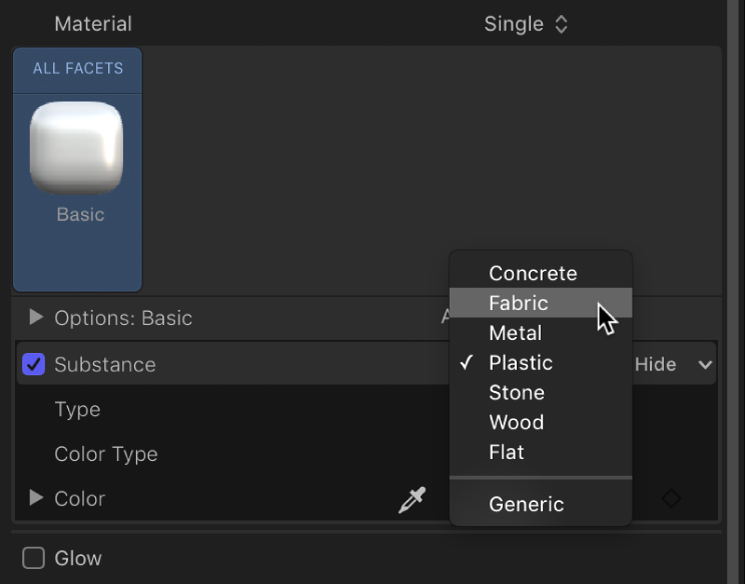
When Substance is set to Concrete
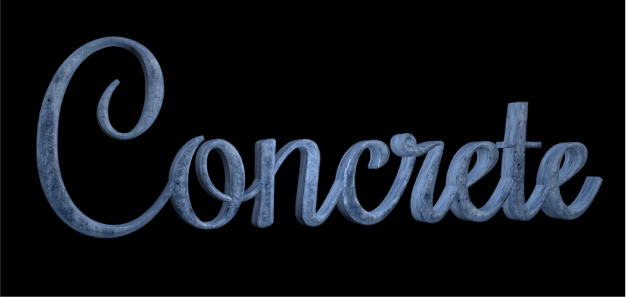
Type: A pop-up menu to choose a style of concrete (Aged, Colored, Smooth, and so on).
Depth: A slider to adjust the depth of surface irregularities in the concrete substance.
Placement: A group of controls (available when you click the disclosure triangle) to set how the concrete pattern is applied to the text object. For details, see 3D text Placement controls in Motion.
When Substance is set to Fabric
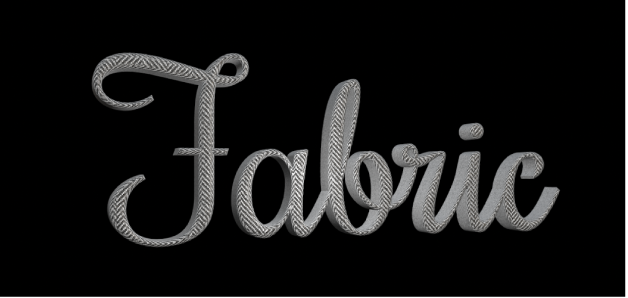
Type: A pop-up menu to choose a style of fabric (Denim, Tweed, Wool, and so on).
Roughness: A slider to adjust how raised and uneven the fabric pattern appears.
Placement: A group of controls (available when you click the disclosure triangle) to set how the fabric pattern is applied to the text object. For details, see 3D text Placement controls in Motion.
When Substance is set to Metal
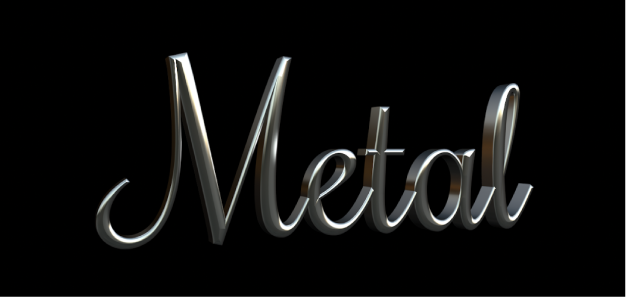
Type: A pop-up menu to choose a style of metal (brass, aluminum, steel, and so on). There’s also a Custom option to modify the gradient for the metal’s reflection. See Example: Customize a metal gradient in Motion.
Shininess: A slider to adjust how reflective the surface appears.
Thickness: A slider to adjust the apparent thickness of the metal surface when it’s applied on top of another substance layer. Control this parameter more precisely by clicking the disclosure triangle, then adjusting individual Base and Highlight sliders.
When Substance is set to Plastic

Type: A pop-up menu to choose any of three plastic styles: Shiny, Matte, or Textured.
Color Type: A pop-up menu to choose whether you want the plastic surface to be a solid color or a gradient. For information on using gradients, see Intro to using the gradient editor in Motion.
Color: A color control (available when Color Type is set to Color) to set the color of the plastic.
Gradient Controls: A gradient control (available when Color Type is set to Gradient) to set a preset gradient or create a custom gradient, and to determine how the gradient is applied to the text object.
Texture Depth: A slider (available when Type is set to Textured) to adjust how visible the texture appears on the object.
Placement: A group of controls (available when Color Type is set to Textured) to determine how the texture is applied to the text object. For details, see 3D text Placement controls in Motion.
When Substance is set to Stone

Type: A pop-up menu to choose a style of stone (Limestone, Dark Granite, Slate, and so on).
Depth: A slider to adjust the depth of surface irregularities in the stone substance.
Placement: A group of controls (available when you click the disclosure triangle) to set how the stone pattern is applied to the text object. For details, see 3D text Placement controls in Motion.
When Substance is set to Wood
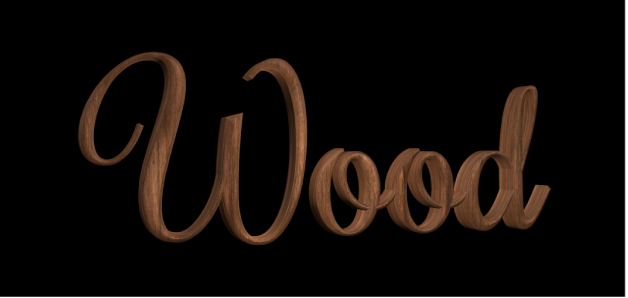
Type: A pop-up menu to choose a style of wood (Ash, Walnut, Bamboo, and so on).
Grain Depth: A slider to adjust the depth of grain in the wood substance.
Placement: A group of controls (available when you click the disclosure triangle) to set how the wood pattern is applied to the text object. For details, see 3D text Placement controls in Motion.
When Substance is set to Flat

Use the Flat substance type to create an object that has depth, but which is unaffected by light or shadows. Flat creates a “2.5-dimensional” look popular in graffiti and pop-art styles.
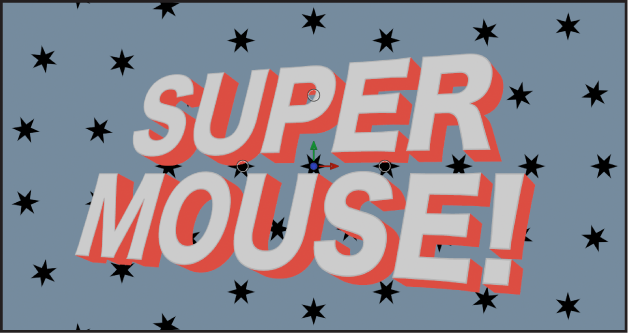
Surface: A pop-up menu to choose whether the surface should display a color, a gradient, or an image. For information on using gradients, see Intro to using the gradient editor in Motion.
Color: A color control (available when Surface is set to Color) to set the color of the text.
Gradient: A gradient control (available when Surface is set to Gradient) to set a preset gradient or create a custom gradient.
Image: An image well (available when Surface is set to Image). Drag an image layer from the Layers list, Media list, Library, or Import dialog into the image well to use as the surface material of the 3D text object.
Wrap Mode: A pop-up menu (available when Surface is set to Image) that determines how the selected image is applied to the 3D text object if the image is smaller or larger than the text object. Choose any of the following options:
None: The image is applied once to the text, and areas of the text object that exceed the scope of the image are not covered.
Repeat: The image is applied and reapplied to the text object as often as necessary, creating a pattern to fill in the area beyond the scope of the original image.
Mirror: The image is applied to the text object, then applied again in an inverted, reversed orientation to cover the area beyond the scope of the original image.
Placement: A group of controls (available when you click the disclosure triangle) to set how the image pattern is applied to the text object. For details, see 3D text Placement controls in Motion.
Intensity: A slider to adjust the vibrancy of the chosen Surface option (Color, Gradient, Image).
Opacity: A slider to adjust the transparency of the chosen Surface option (Color, Gradient, Image). Drag to the left to make the surface appear more transparent; drag to the right to make the surface appear more opaque.
Enable Edge: A group of controls (available when you click Show on the right side of the heading row) that creates a dynamic effect for how edges are rendered depending on the relative position of the camera. As the text changes position (relative to the camera) the shading changes.
You can enable or disable these controls by selecting or deselecting the activation checkbox to the left of the Enable Edge row.
Edge Amount: A slider to adjust how visible the edges of the selected substance layer appear.
Invert: A checkbox that, when selected, inverts the visible area of the edges for the selected substance layer.
Blend Mode: A pop-up menu to control how flat substance layers interact with layers beneath them. Choose any of the following methods:
Normal: The visible areas of the topmost substance layer obscures the edges of the layers beneath it.
Multiply: The visible areas of the substance layers are multiplied together so the darker areas of each layer appear on the edges of the text object.
Add: The visible areas of the layers are added together so the lighter areas of each layer appear on the edges of the text object.
When Substance is set to Generic
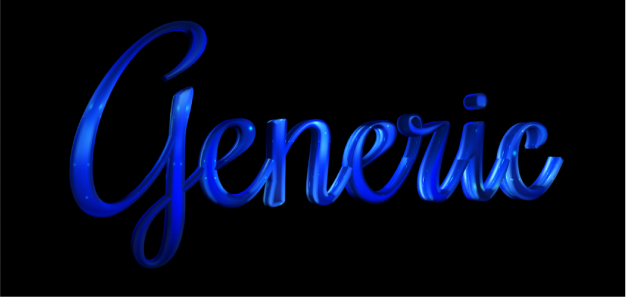
The generic substance type (often called “diffuse” in other 3D applications) is used in several of the preset materials available in the Library. When Substance is set to Generic, a neutral surface is generated, onto which a solid color, gradient, or image can be applied. This substance type is usually used in conjunction with the Custom Specular or Custom Bump finish layers to create unique looks.
Surface: A pop-up menu to choose whether the surface should display a color, a gradient, or an image.
Color: A color control (available when Surface is set to Color) to set the color of the paint.
Gradient: A gradient control (available when Surface is set to Gradient) to set a preset gradient or create a custom gradient. For information on using gradients, see Intro to using the gradient editor in Motion.
Image: An image well (available when Surface is set to Image). Drag an image layer from the Layers list, Media list, or Library into the image well to use as the surface material of the 3D text object. See Apply a custom material to 3D text in Motion.
Placement: A group of controls (available when Surface is set to Image) to determine how the image is applied to the text object. For details, see 3D text Placement controls in Motion.
Wrap Mode: A pop-up menu (available when Surface is set to Image) to choose how the selected image is applied to the 3D text object if the image is smaller or larger than the 3D text object. Choose any of the following options:
None: The image is applied once, and areas of the text object that exceed the scope of the image are not covered.
Repeat: The image is applied and reapplied as often as necessary, creating a pattern to fill the area beyond the scope of the original image.
Mirror: The image is applied to the text object, then applied again in an inverted, reversed orientation to cover the area beyond the scope of the original image.
Brightness: A slider to adjust how much light is reflected by the surface of the text object. Control this effect with more precision by clicking the disclosure triangle and separately adjusting the following subcontrols:
Lights: A slider to adjust the amount of light reflected in the object’s surface, based on the light type chosen in the Lighting Style pop-up menu (in the Lighting group of controls).
Environment: A slider to adjust the amount of light reflected in the object’s surface, based on the environment type chosen in the Environment Type pop-up menu (in the Lighting group of controls).
Opacity: A slider to adjust the visibility of the substance layer. Drag to the left to make the substance more transparent, or drag to the right to make it more opaque.